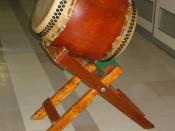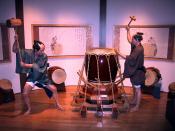Taiko: A Blossoming Art
As a musician I am continually searching for new instruments and sounds to experiment with. Percussion is my forte' and for years I have been fascinated with the monstrous drums of Asia, in particular Japan's Taiko, or "fat drum". The word Taiko refers not only to the enormous barrel shaped drum, which now comes in many different sizes, but also the music itself. Almost everyone has seen a movie or an image of a muscle bound man pounding a gigantic drum with sticks that resemble axe handles perched upon high in a temple or religious ceremony. At least this is the image that I remember and this is the way it was, that is, until it was given a facelift in the 20th century. It can be said that Japan is society who prides themselves in seclusion and tradition. I believe that it is because of this mentality that the art form of Taiko has quickly become Japan's number one native musical export to spread worldwide.
In contrast it took the influence of the west to make Taiko the ensemble powerhouse and musical force that is today. To better understand the impact of Taiko music we must first journey to ancient Japan where the Taiko art form was born.
The exact origin of Taiko has always been shrouded in mystery, but that's not to say that there are no compelling answers and facts that together explain its beginnings. The first piece of physical evidence came in the form of a clay Haniwa figure, which dated Taiko as far back as the sixth century. It is known that Japan has in the past borrowed musical instruments, scales, styles and such from its culture rich neighbors, so it makes perfect sense that Taiko's origins are of the same.


